$0.00
Ebook description: 3100 words. Many images and a video link. Illustrative artwork included by the author. Watercolours and ink.
SYNOPSIS;
*Comparing and contrasting the novels Moby Dick (by Herman Melville), and Macbeth (by William Shakespeare). Article: William Van Zyl (Published in 2021).
Read the full article for free: https://fivehousepublishing.com/writing-skills-wood-and-stone-how-prophecy-changes-everything-2/
LISTEN TO THE PODCAST:
READ THE ARTICLE AS A BLOG POST:
EXCERPT:
Fantasy Prophecy is a fascinating and compelling technique for Writing Fiction and Non-fiction.
Prophecies, or a prophecy, can add a fascinating plotline to a novel. It gives depth. It cleverly weaves mystery and suspense into the fabric of the story. It elevates the storyline. It intrigues!
[Prophesy] instils [a] story with a great sense of importance – as if the ages were just waiting for this one conjuncture of events, or particular character to come to prominence. It can sometimes be found in historical novels, but it is fantasy writing that the use of prophecy is far more common, becoming almost an art form in itself. Many readers may think that creating a fictitious prophecy would be straightforward, but it certainly isn’t, and it is especially difficult if you wish to imbue it with a high level of mystery and complexity. After sprinkling prophecy throughout Game of Thrones, George R R Martin said ‘Prophecies are, you know, a double edge sword. You have to handle them very carefully; I mean, they can add depth and interest to a book, but you don’t want to be too literal or too easy…’
Credit: Thomas M D Brooke. Link https://thomasmdbrooke.com/2016/08/11/great-fantasy-prophecies/
When writers use this technique successfully – just like Herman Melville in Moby Dick and Shakespeare in Macbeth –advances their stories to a new level. The two famous authors display their accomplished writing skills by applying this technique very successfully. They produce anticipation, mystery, and suspense.
In this article, I look at these techniques. I also touch on prophesy and non-fiction writing. For example:
Non-fiction prophecy-skill techniques
A great example of non-fiction storytelling is the book: Hiroshima.
Hiroshima is a 1946 book by Pulitzer Prize-winning author John Hersey. It tells the stories of six survivors of the atomic bomb dropped on Hiroshima. It is regarded as one of the earliest examples of the New Journalism, in which the storytelling techniques of fiction are adapted to non-fiction reporting.
Here is a short excerpt of the book Hiroshima. I have added – just for fun – a prophecy at the beginning (in brackets, the first three sentences). The rest of the excerpt is the excellent non-fiction work of John Hersey – outstanding non-fiction writing:
[Little Boy had a tumour in its belly. The tumour had a self-fulfilling prophecy written in damaged DNA code. What would Little Boy’s message be?]
‘At exactly fifteen minutes past eight in the morning, on August 6th, 1945, Japanese time, at the moment when the atomic bomb flashed above Hiroshima, Miss Toshiko Sasaki, a clerk in the personnel department at the East Asia Tin Works, had just sat down at her place in the plant office and was turning her head to speak to the girl at the next desk. At that same moment, Dr. Masakazu Fujii was settling down cross-legged to read the Osaka Asahi on the porch of his private hospital, overhanging one of the seven deltaic rivers which divide Hiroshima; Mrs. Hatsuyo Nakamura, a tailor’s widow, stood by the window of her kitchen watching a neighbor tearing down his house because it lay in the path of an air-raid-defense fire lane; Father Wilhelm Kleinsorge, a German priest of the Society of Jesus, reclined in his underwear on a cot on the top floor of his order’s three-story mission house, reading a Jesuit magazine, Stimmen der Zeit; Dr. Terufumi Sasaki, a young member of the surgical staff of the city’s large, modern Red Cross Hospital, walked along one of the hospital corridors with a blood specimen for a Wassennann test in his hand; and the Reverend Mr. Kiyoshi Tammoto, pastor of the Hiroshima Methodist Church, paused at the door of a rich man’s house in Koi, the city’s western suburb, and prepared to unload a handcart full of things he had evacuated from town in fear of the massive B-29 raid which everyone expected Hiroshima to suffer. A hundred thousand people were killed by the atomic bomb, and these six were among the survivors. They still wonder why they lived when so many others died. Each of them counts many small items of chance or volition—a step taken in time, a decision to go indoors, catching one street-car instead of the next that spared him. And now each knows that in the act of survival he lived a dozen lives and saw more death than he ever thought he would see. At the time none of them knew anything.’
Description
Read the full article for free: https://fivehousepublishing.com/writing-skills-wood-and-stone-how-prophecy-changes-everything-2/
EXCERPT: 1
Introduction
Here are two such prophecies – I will compare the two famous authors’ work briefly in this short article. When I compared Macbeth and Moby Dick, the application of this technique stood out for me. It is so powerful! See the watercolour illustrations from my sketchbook.
EXCERPT: 2 – MACBETH & MOBY DICK
Macbeth will not be defeated till “Birnam Wood comes to Dunsinane (castle).” Not until Wood (Dunsinane forest) comes to stone (the castle).
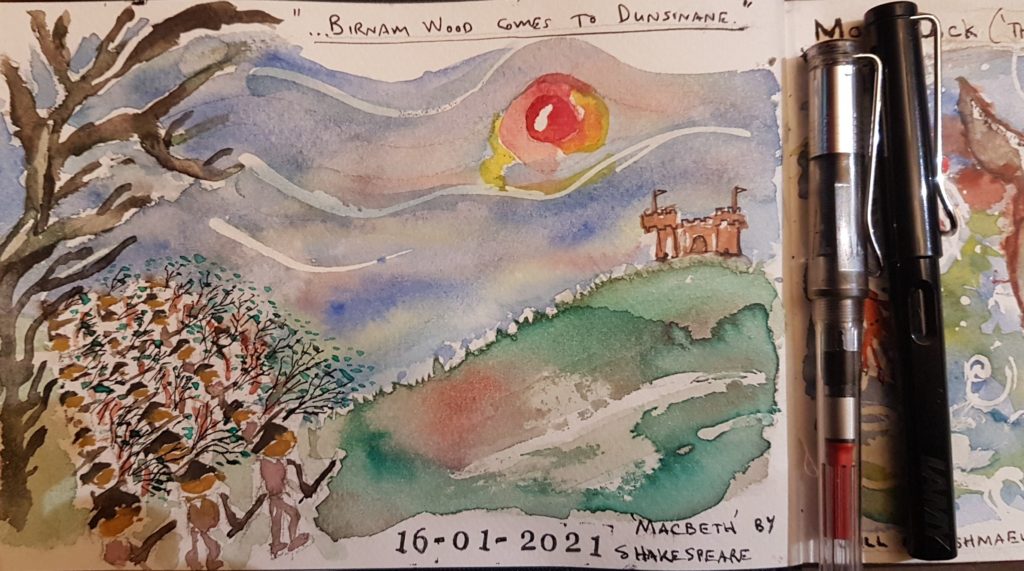
From the author’s sketchbook: The Tragedy of Macbeth by Shakespeare. Malcolm’s soldiers were carrying the branches of Birnam Wood toward Dunsinane Castle to obscure their numbers. In the play, Macbeth is a Scottish general under the rule of King Duncan. Three witches tell Macbeth that he will become king of Scotland. Macbeth is spurred by his ambition and his wife, murdering Duncan and acceding to the throne. His reign is bloody and tyrannical and is ended by the combined forces of Scotland and England, published in 1623.
MOBY DICK
For Captain Ahab (Moby Dick), a prophecy is given that he “will die when two hearses, one ‘not made by mortal hands’, and one made of wood from America,” appears.
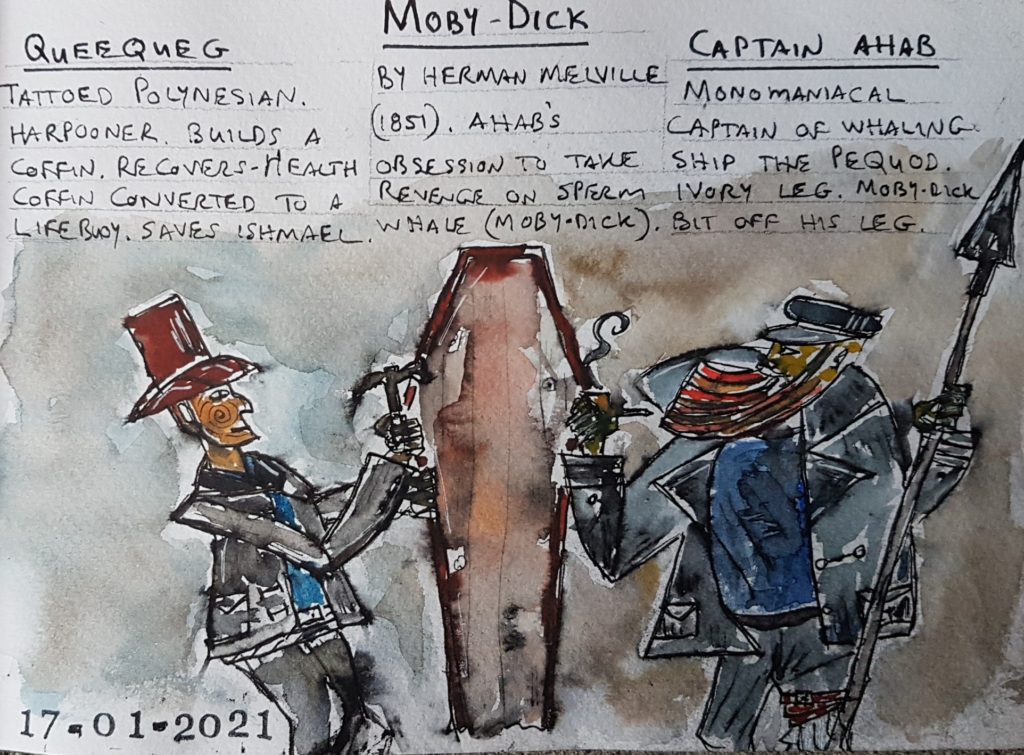
Sketchbook: Queequeg and Captain Ahab from the novel Moby Dick. Credit: William Van Zyl
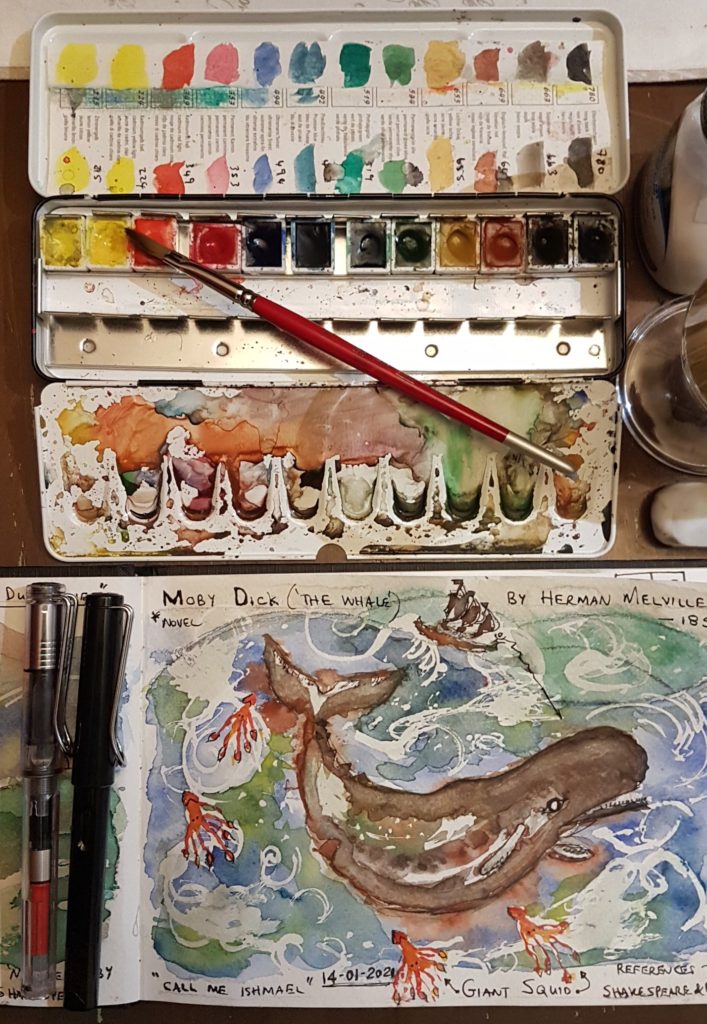
Sketchbook: Moby-Dick; or, ‘The Whale’ is an 1851 novel by American writer Herman Melville. The book is the sailor Ishmael’s narrative of Ahab’s obsessive quest, captain of the whaling ship Pequod, for revenge on Moby Dick. During the ship’s giant-white-sperm-whale-voyage the whale bit Ahab’s leg off at the knee.
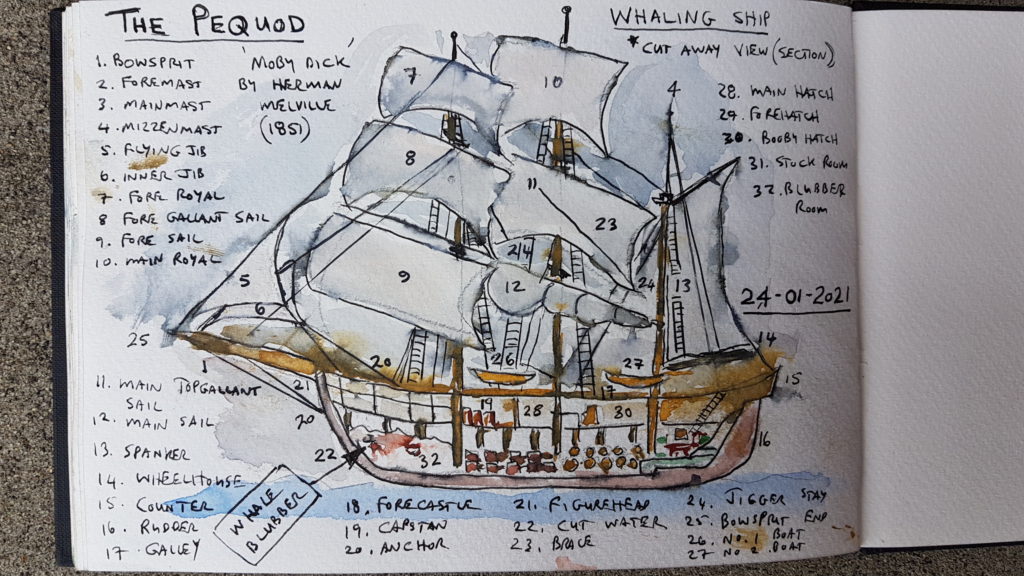
From the author’s Sketchbook: The Pequod is a fictional 19th-century Nantucket whaling ship that appears in the 1851 novel Moby-Dick by American author Herman Melville. Credit: William Van Zyl (watercolours and ink).
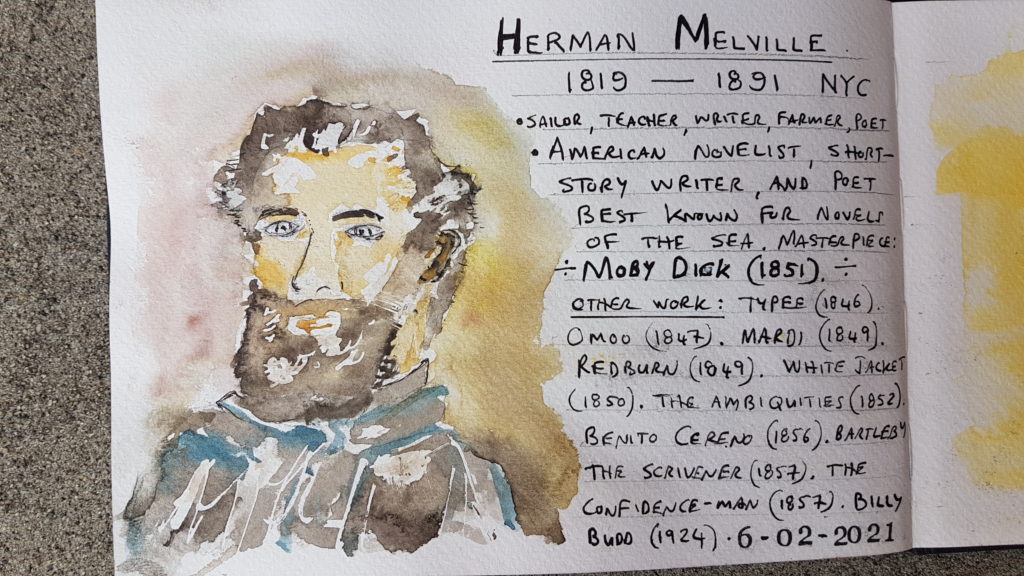
Herman Melville. Credit: William Van Zyl.
Three famous quotes by Melville:
It is not down in any map; true places never are.
Better sleep with a sober cannibal than a drunken Christian.
To the last, I grapple with thee; From Hell’s heart, I stab at thee; For hate’s sake, I spit my last breath at thee.
Excerpts from Macbeth
For Macbeth, there is a range of prophecies, which builds the drama. The three weird Sisters prophesied, “The power of man, for none of woman born shall harm Macbeth.” The three weird sisters produce several prophecies in the opening of the play:
First Witch
All hail, Macbeth! Hail to thee, thane of Glamis!
Second Witch
All hail, Macbeth! Hail to thee, thane of Cawdor!
Third Witch
All hail, Macbeth, that shalt be king hereafter!
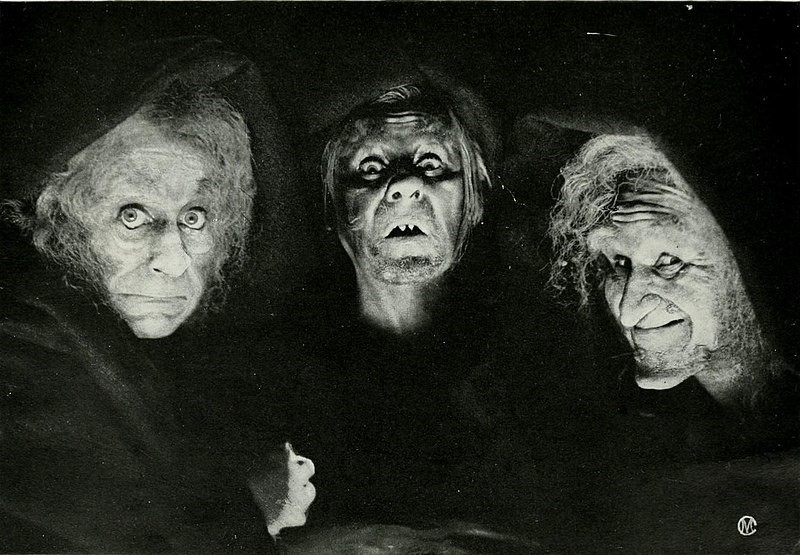
The three witches (weird sisters) in Macbeth (Shakespeare). The Three Witches in Macbeth, each portrayed by Cavendish Morton. “As I have been so frequently asked how I managed to get three photographs of myself in one print, I may explain that separate negatives were taken, which were subsequently combined in a composite print.” Credit: Cavendish Morton, Public domain, via Wikimedia Commons.
EXCERPT: 3 – THE MATRIX
More on prophesy, self-fulfilling prophesy, and writing
The movie The Matrix, referring to the vase scene, is an excellent example of how powerful a story’s prophecy is. See the event 33 seconds into the video.
Here is a link to the short video of the vase scene (Matrix): https://youtu.be/eVF4kebiks4
Related products
-

Dressing Well: A Style Compass and Map for Rookies – the Stuck-in-a-rut Fly Fisherman Story.
$0.00 Add to cart -

Out-Foxed (two one page stories).
$0.00 Add to cart -

Man finds $ 43,170 and returns it—he stuns the world by ‘building’ a lighthouse that attracts snow-white birds.
$0.00 Add to cart -

Leadership: Two things you could do today to create a culture in your family or organisation.
$0.99 Add to cart

